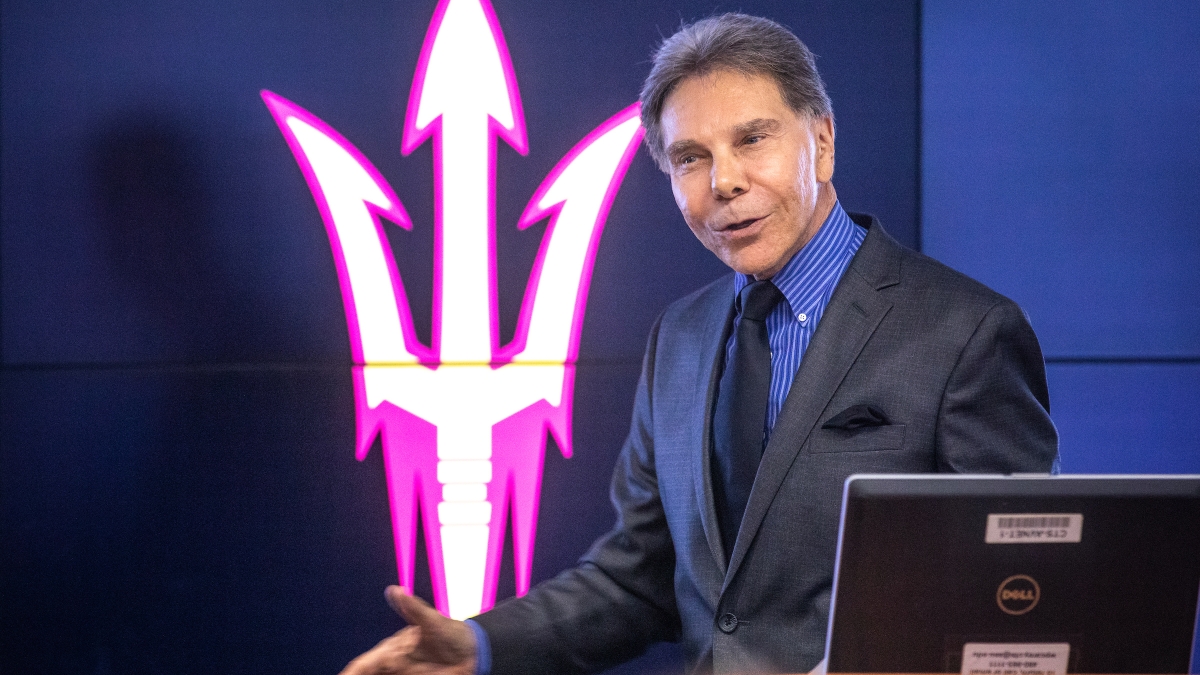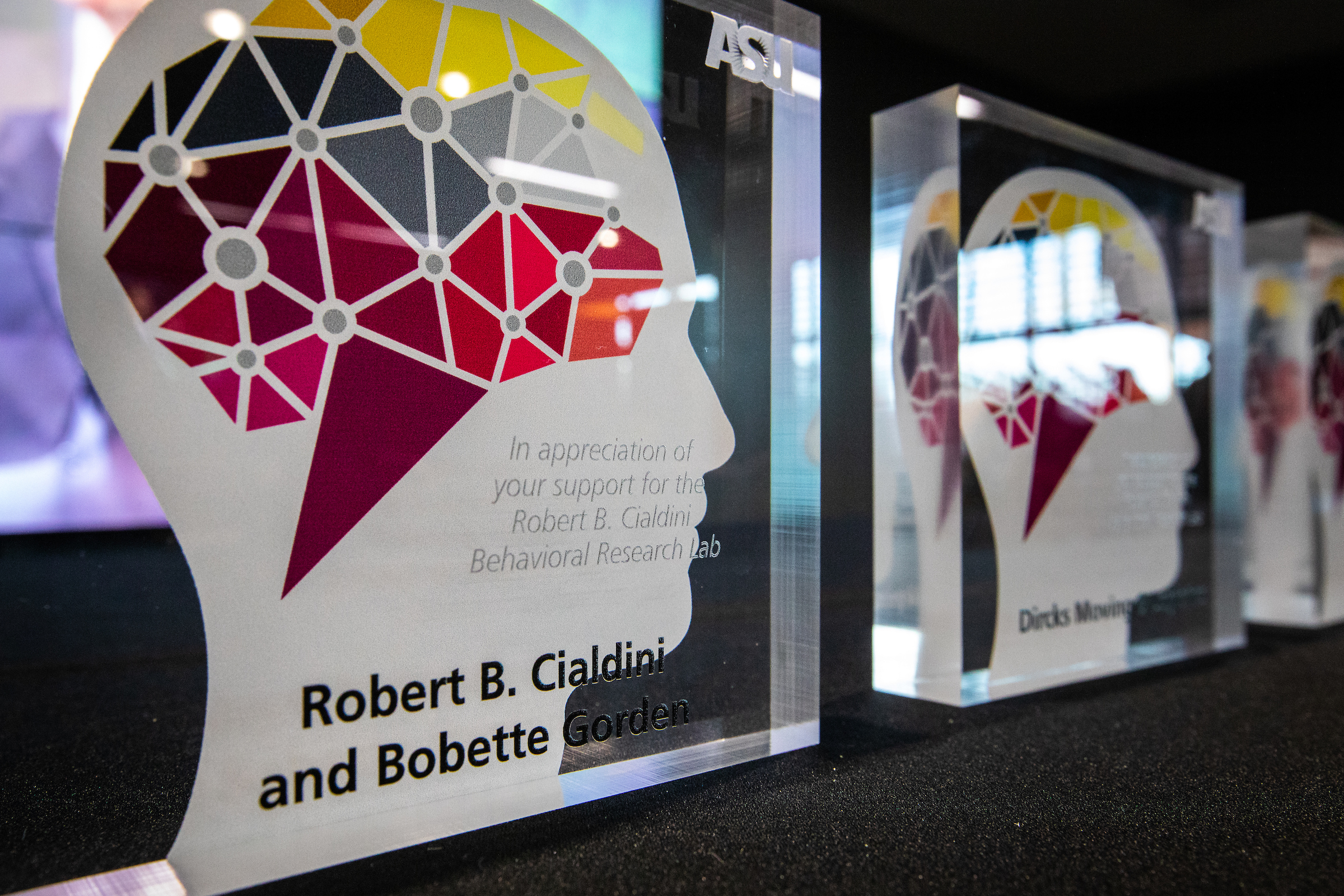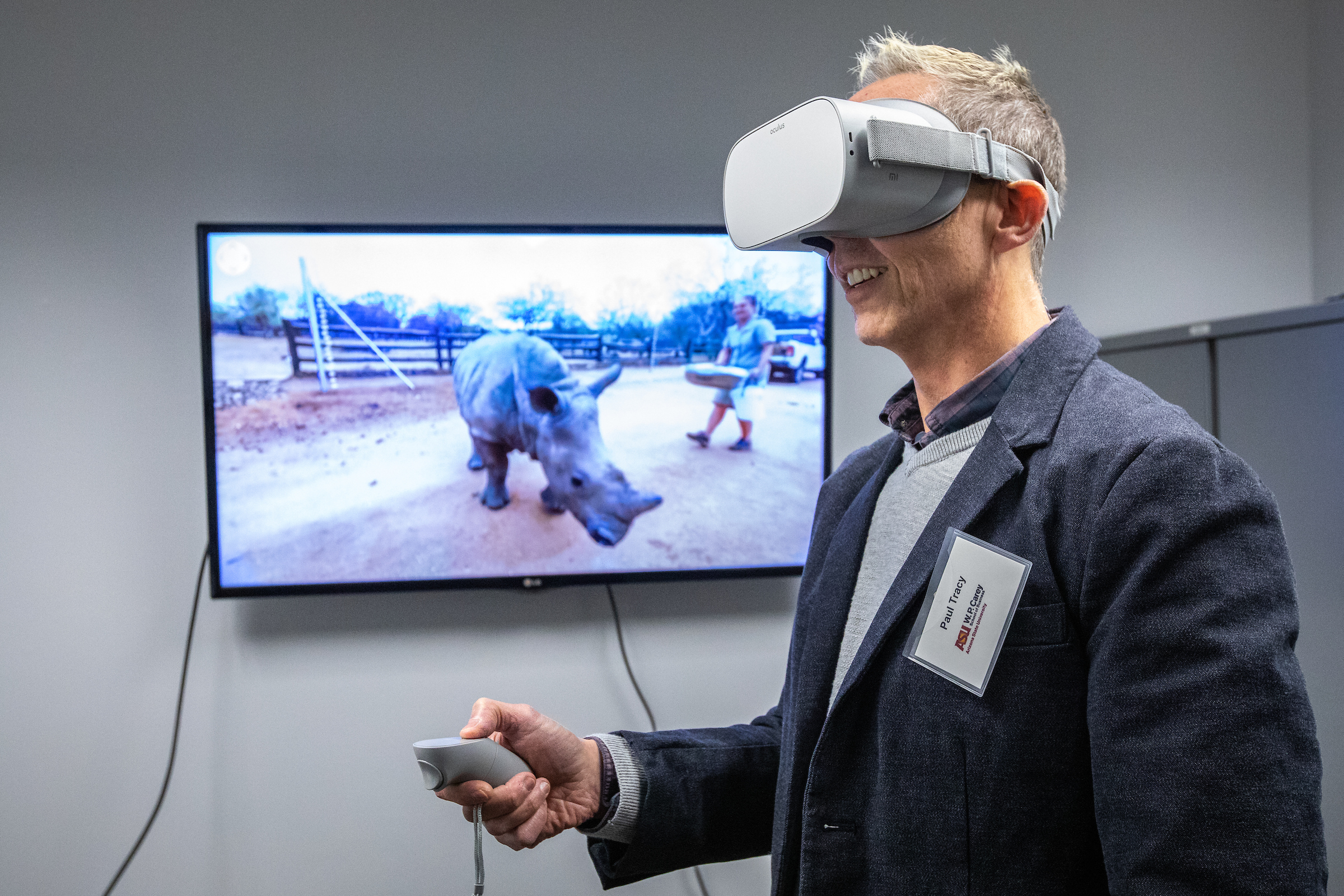Robert Cialdini’s work in fusing social psychology and marketing led to a new way of thinking about consumer behavior and launched a best-selling book. Now, one of the most important resources in the W. P. Carey School of Business at Arizona State University is being named for this world-class scholar.
Cialdini’s work has made him the “maestro of persuasion and influence,” said Amy Hillman, dean of the W. P. Carey School of Business, at an event marking the naming on Tuesday night.
“I think faculty in this room would tell you that we idolize Bob so much because he’s not only a scholar among scholars but is truly is a thought leader in taking his own research and the research of others to practice, and that’s what we all try to do.”
Cialdini, an emeritus professor who retired in 2009, wrote the best-selling book “Influence: The Psychology of Persuasion” in 1984. He told the crowd at McCord Hall on Tuesday night that his joint appointment in the departments of psychology and marketing was key.
“It was so fruitful to me in the way we were able to collaborate,” he said. “There was good research that came out of those collaborations but also in terms of stimulating my thinking for doing research that has implications, not just theoretical, but in the way exchanges occur in the real world.”
The lab, in the Business Administration C-Wing, was previously just called the behavioral research lab, but having Cialdini’s name on it will increase the credibility, Hillman said.
Robert Cialdini and his wife, Bobette Gorden, are among those who received appreciation plaques at the naming ceremony on Tuesday. Photo by Charlie Leight/ASU Now
“The Robert B. Cialdini Behavioral Research Lab represents the legacy of one of our most prominent faculty members over the past several decades as well as the promise and impact of our research for decades to come,” she said.
“The lab conducts more than 200 separate behavioral experiments each year and is a vital resource for our faculty, students and community."
Amy Ostrom, chairman of the marketing department, said the investment will take the lab to the next level, expanding its work into the community and widening the study participant base well beyond undergraduates.
“One of the issues we have with all types of research done with a student population is that you just can’t ask all the questions you might be interested in asking,” she said, such as decisions about health care or financial services.
“We’re interested in creating a mobile lab — pulling together resources that our researchers can take out into the field, wherever that might be.”
The mobile research lab might be a pop-up site that allows for data collection in a controlled environment.
“We’re looking at everything it would take to conduct rigorous research in the field,” said Ostrom, who holds the PetSmart Chair in Service Leadership.
Ostrom said the renaming is especially poignant for her. When she was an undergraduate at ASU majoring in psychology, she took a class that Cialdini taught.
“I thought it was the best thing I had ever experienced, and I asked if I could be his research assistant. He really helped establish my love of research,” she said, adding that Cialdini also supervised her honors thesis.
“To come full circle and be part of having him invest in the lab and having the lab named after him is personally very meaningful.”
Studying real behavior
Cialdini’s transdisciplinary work in psychology and marketing is key to the mission of the lab, which extends beyond asking people, “Would you buy this?” Studies in the lab go much deeper, asking participants about topics ranging from group identity to recycling habits.
Most of the studies are taken online with subjects sometimes watching a video, but some are “experiential,” with the research assistants doing role play, in which they follow a scripted scenario to determine a subject’s response.
Recent studies done in the lab include one by Adriana Samper, an associate professor of marketing, that used an experiential study to look at how face-to-face conversations affect opinions about products, and another by Samper and a doctoral student that found that people use a lot less paper products when the items are pretty.
Andrea Morales, a professor of marketing, said the lab "is like oxygen to a consumer-behavior scholar."
Paul Tracy, a friend of Robert Cialdini, checks out the virtual reality experience in the Robert B. Cialdini Behavioral Research Lab in the W. P. Carey School of Business on Tuesday. Photo by Charlie Leight/ASU Now
"I’m a consumer psychologist, which means I spend most of my time trying to figure out why people do the things they do. I develop and test theories of consumer behavior by running experiments in order to establish clear cause-and-effect relationships," said Morales, who is faculty director of the lab. "Without the lab, I wouldn’t have a research program."
The Robert B. Cialdini Behavioral Research Lab is unique because of its scope, flexibility and engagement with students, she said.
"A lot of business schools have labs that often sit empty because they don’t have enough students to participate in their studies. In contrast, our lab is open every day, with studies running every day. We are one of the most productive and cost-efficient labs in the country," said Morales, who holds the Lonnie L. Ostrom Chair in Business.
The research provides insight into real consumer behavior, which means enhancing the realism and behavioral aspects of the research as much as possible.
"For example, instead of asking people their hypothetical purchase intentions for various products, we set up a room in the lab to look like an actual store and send participants in with real money to make a purchase of their choice," she said.
"In another study, instead of measuring aggression on a self-reported scale, the lab had participants play a boxing video game and recorded the number of punches they threw in order to see if scarcity ads, like those you see on Black Friday that advertise 'Only three available,' promote aggressive behavior in consumers."
Morales studies the concept of disgust, which involves keeping vomit-flavored jelly beans in the lab.
"Finding creative and compelling ways to test our theories is what we're all about," she said.
During the 2017-18 academic year, the lab had an average of 335 online participants and 250 in-person participants per week. All of that is managed with the help of six undergraduates who are employed as research assistants.
“The undergraduate research assistants are core to the functioning of the lab,” Ostrom said.
“It’s a great conduit for undergraduates to explore research, especially for those who are interesting in eventually pursuing an academic career.”
Learning to sell cars
Cialdini, who first came to ASU in 1971, said that studying behavior is the most important kind of consumer research.
“Research into how people are feeling, what they believe, what their attitudes are — that’s in the service of their behavior,” he said.
Cialdini’s interest in studying influence was piqued early on, when he realized he was a pushover: “I noticed I would buy things that I didn’t need or contribute to causes I didn’t know much about,” he said.
“It must have been something other than the merits of the offer — the psychology of the delivery of the offer. And that just intrigued me. What would that psychology look like if I tried to research it?”
He started studying influence in a lab, typically using college students who knew their responses were being evaluated. But he realized he needed to look at the real marketplace. So he started answering ads to train in as many influence professions as he could.
“I learned how to sell automobiles on a lot. I learned how to sell portrait photography over the phone. I learned how to sell encyclopedias door to door. I learned how to sell insurance from an office,” he said.
He studied training programs of charities and military recruiters.
“I interviewed cult recruiters. What do they do to move people and hold them in their sway?”
He worked “undercover” and learned hundreds of tactics and techniques, but eventually recognized that most of it could be boiled down to six principles. “And I realized, ‘Oh, there’s a book here.’”
So he wrote “Influence: The Psychology of Persuasion,” with a chapter devoted to each influence principle: reciprocation, commitment and consistency, social proof, liking, authority and scarcity. The book, published in 1984, has sold more than 3 million copies and has been translated into more than 30 languages.
Later, Cialdini updated the book to include a seventh principle, unity.
“If we can convince people that we share an identity with them, the influence process becomes dramatically easier,” he said. “That’s relevant today with this notion of tribalism as determining a lot of our political decisions and choices, for example.”
Cialdini has written several other books, most recently, “Pre-Suasion: A Revolutionary Way to Influence and Persuade,” in 2016.
“The book tries to answer: What can you do to make people agree with your message before they encounter it?” he said. “That sounds like some kind of magic, but it’s established science.”
He described a research project involving online influences published in 2002 and co-authored by Naomi Mandel, a professor of marketing in the W. P. Carey School of Business. The subjects in her study visited a furniture website and encountered one of two wallpaper backgrounds. Subjects who saw fluffy clouds were more like to cite comfort as an important furniture feature, and subjects who saw a wallpaper of pennies were more likely to cite price.
“This is what ‘pre-suasion’ does — it puts you in a state of mind,” Cialdini said.
Cialdini maintains an office on campus and continues to research and write about influence. He co-authored an article last year in Scientific American titled, “How to Overcome Antiscientific Thinking.”
His blockbuster "Influence," which he's updating to include social media and e-commerce, was written at a time when behavioral scientists were not writing for nonacademic audiences.
"They were worried they would be characterized as writing ‘pop psychology,'” he said. But he avoided that reaction because he supported his conclusions with hundreds of research citations.
"I tried to elevate an approach to research — the approach of experimental behavioral science.”
Top photo: Robert Cialdini expresses his gratitude to donors, colleagues and his wife at the naming ceremony of the Robert B. Cialdini Behavioral Research Lab in the W. P. Carey School of Business on Tuesday. The lab, named after the emeritus professor, will enable students to develop and test theories in consumer behavior in realistic experimental situations. Photo by Charlie Leight/ASU Now
More Health and medicine

College of Health Solutions launches first-of-its-kind diagnostics industry partnership to train the workforce of tomorrow
From 2007 to 2022, cytotechnology certification examinees diminished from 246 to 109 per year. With only 19 programs in the United States, the cytology workforce that stands at the front line of…

ASU's Roybal Center aims to give older adults experiencing cognitive decline more independence
For older people living alone and suffering from cognitive decline, life can be an unsettling and sometimes scary experience.Arizona State University is out to improve that experience.Two projects…

Dynamic data duo advances health research
The latest health research promises futuristic treatments, from cancer vaccines to bioengineered organs for transplants to medical nanobots. While these technologies may one day be…




